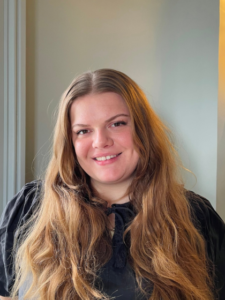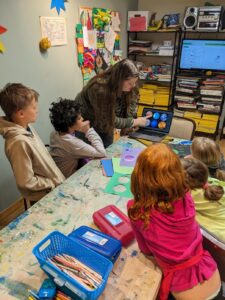A Farewell to the Treasure State by Liv Sorenson

This week in national service, I became a Certified Interpretive Guide. It’s an official declaration that I learned how to structure interpretive experiences and talks at museums and galleries; which I think will be useful to reworking the volunteer museum docent training materials at my service site. My class took a trip to the MMAC (Montana Museum of Arts and Culture) in Missoula as part of the course. It was there that I came across “Animals Crossing a Bridge” by the 19th Century French painter Jules Dupre.
It’s a plein-air style depiction of a few cattle meandering over a bridge from one grassy bank to another, with a man on a horse driving from behind. I think that the content of the painting alone could be something from Montana, a cattle drive for branding perhaps. I didn’t necessarily seek this painting out but I still felt drawn to it. It’s not from nor does it depict Montana, but it made me start to think about what the Treasure State gives and how I can give back as I near the end of my VIS TA service. So, when it came time to present my interpretive talk to imaginary gallery visitors in order to receive my certification, I presented a picture of “Animals Crossing a Bridge,” and began with a question: What is fine art in Montana? If I was asked this question a year ago, I would have thought about large-scale mountain scenes with muted color and dots of bison in the distance. I would have maybe thought about stylistic portraits of men in western wear. I certainly would not have thought of romantic-era French painters. But, of course, my service has immersed me in the art and museums scene in Montana and has changed my perspective. When it comes to fine art in Montana, I now think about the people and the art that I have come across in 10 months of service. I think about thick plaster cross-sectioned by grinders, prints of birds with skeletal parts to represent environmental damage, and the resurrection of traditional sign-painting for social causes.
TA service. So, when it came time to present my interpretive talk to imaginary gallery visitors in order to receive my certification, I presented a picture of “Animals Crossing a Bridge,” and began with a question: What is fine art in Montana? If I was asked this question a year ago, I would have thought about large-scale mountain scenes with muted color and dots of bison in the distance. I would have maybe thought about stylistic portraits of men in western wear. I certainly would not have thought of romantic-era French painters. But, of course, my service has immersed me in the art and museums scene in Montana and has changed my perspective. When it comes to fine art in Montana, I now think about the people and the art that I have come across in 10 months of service. I think about thick plaster cross-sectioned by grinders, prints of birds with skeletal parts to represent environmental damage, and the resurrection of traditional sign-painting for social causes.
These sorts of works all emerge from the self-aware dump that is Butte. There is a unique culture here, which has inspired the bulk of my service work this spring and early summer. I became aware of all of the great open mics, galleries, workshops, lectures, and concerts over the course of living in the historic district. I also unfortunately became aware of how difficult it can be to know about these events between different websites and social media accounts, especially with the downfall of the newspaper here. Thus, a new project was born. I took the initiative to create the C.A.N. (community arts newsletter), a monthly collection of articles and a collaborative calendar that details all of these events. We have been working on slowly rolling it out and gaining community interest. There is a lot of art here, it just takes researching, emailing, circling back on emails, formatting, printing, and distributing to get it into a presentable format. As it continues on by the month, I hope that more people and people who may have not already be en present start to show up for the Chateau’s events, but to other fantastic and free arts programming around town.
en present start to show up for the Chateau’s events, but to other fantastic and free arts programming around town.
I would say that my project has been a success so far, despite it needing an endless amount of redirection. I think of one moment that I was hanging out at the iconic Pekin Noodle Parlor, and noticed that someone nearby had a copy of the newsletter sticking out of their bag, with events underlined and highlighted. It feels like a little confirmation that my work has an impact. It feels like a little something that I have been able to give Butte that will hopefully last beyond my time here.
Montana fine art actually does include a painting like “Animals Crossing a Bridge.” But, in all honesty, I don’t think that it’s that spectacular of a painting. But, what made it Montana Fine Art in my mind was more so derived from external context. Start with the literal frame it’s in: an ornate gilded wooden frame likely from the turn of the last century. Long story short, the majority of this painting’s existence has been spent in the hands of the Clarks. The Clarks were once one of the wealthiest families in the world, thanks to the wealth of copper underneath Butte. In fact, they had enough money to build a mansion in the likes of a French castle that I now sit in as I write this post. And it would not be a shock to you if you have been to Butte before upon hearing that this sort of money left Butte. The money was used elsewhere in the world, and eventually bought a huge collection of art from the old masters, and from French impressionists like Dupre. As the former director of the MMAC said, “Historians have long lamented that W.A. Clark and others who made their fortunes off Montana copper mostly used their vast wealth elsewhere, leaving Montanans with virtually nothing except the environmental cleanup.”
The Clark collection had been housed in Washington DC before people petitioned for some pieces to return to Montana. The request was granted, and UM’s Clark collection is now the only portion of the larger collection that left the east coast.
The treasure state has given so much to the study of history. Countless native beadworks and regalia, rare mineral samples, and dinosaur bones from Montana sit in museums and universities out of the state and country. Likewise, this area of southwest Montana gave the resources and especially the decades of hard labor in exchange for one of America’s largest fortunes. I am also well aware that Butte gave me so much. I know that I gave a year of service to them, but I am grateful for what Butte’s community has shared with me. I couldn’t have predicted how it would happen, but serving at the Clark Chateau and working with artists, young creators, musicians, and especially the staff at the Butte-Silver Bow Public Archives set me on what I hope will be a meaningful career. These people and the mission to make the arts accessible to people in Montana is what, to me, makes fine art in Montana. And without these experiences, I would have never had the qualifications or the belief in myself to apply to the masters program that I will be starting this fall.
When I saw the painting in Missoula, I saw it as a symbol of what Montana has given, and what Montanans deserve in return. Likewise, I hope that my education, career, and life after AmeriCorps will eventually allow me to return some of the wealth of the world’s art and museum knowledge back to Montana
 Blog
Blog